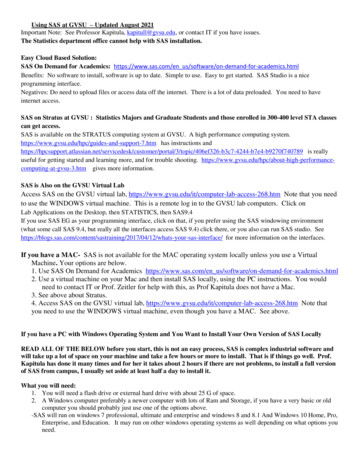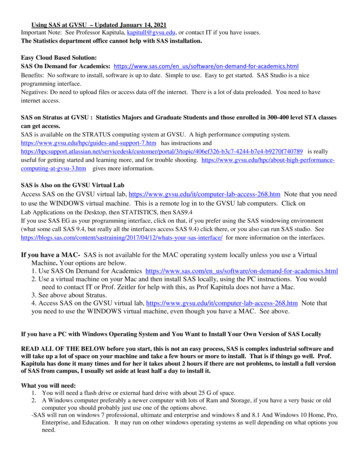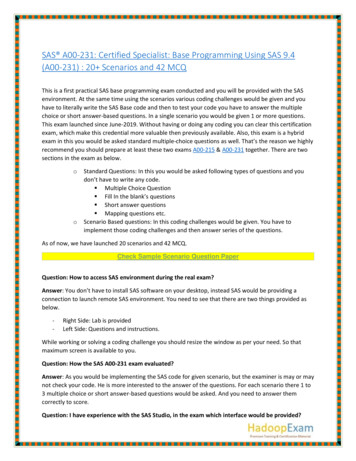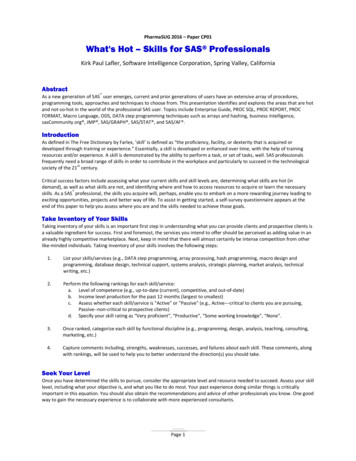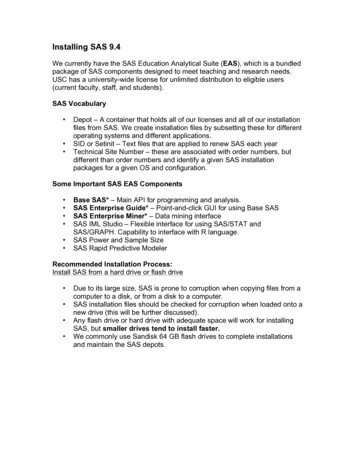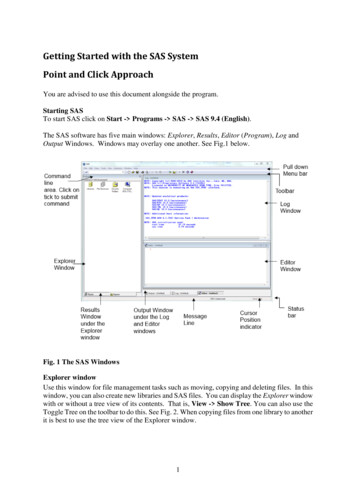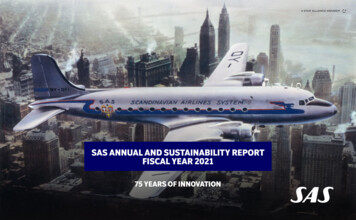
Transcription
SAS ANNUAL AND SUSTAINABILITY REPORTFISCAL YEAR 202175 YEARS OF INNOVATION
OPERATIONSSAS in brief 3SAS in figures 4Significant eventsduring the year Commentsby the CEO 68MARKET ANDSTRATEGYFINANCIALINSTRUMENTSThe airline operatingenvironment 12SAS as aninvestment Strategy Financial instrumentsand capital markets 2213- Preferred airline forScandinavia'stravelers 14- Modern single t ype fleet 15- Fully competitiveoperating model 1620REPORT BY THEBOARD OF ort by the Boardof Directors 24Consolidatedfinancial statements 58Sustainability 110Dividend, dispositionof earnings andoutlook 41Overview of notes 63Environment 114Employees 121Ten-year financialoverview 137Business 123Definitions 139GRI content Index 129Shareholderinformation 141Assurance report 132Destinations 142CorporateGovernance Report 42- Board of Directors 53- Groupmanagement 55Notes to theconsolidatedfinancial statements 64Parent Companyfinancialstatements 99OTHERAbout this report 126Operationalkey figures 135Notes to ParentCompany financialstatements 101- Global leadershipin sustainableaviation 17Signatures 102How we create value 18Auditors’ report 103SAS ANNUAL AND SUSTAINABILITY REPORT FISCAL YEAR 2021SAS reports financial and sustainability information in a joint report: SASAnnual and Sustainability Report Fiscal Year 2021 (FY 2021). The SASstatutory annual report includes the report by the Board of Directors onpages 24–56 and the financial statements pages 57–102. The sustainabilityreporting has been prepared in accordance with the GRI Standards: Coreoption and comprises pages 110–131. The sustainability reporting alsoincludes the statutory sustainability report in accordance with the SwedishAnnual Accounts Act. The auditor’s opinion on the annual report is includedon pages 103-108 and the auditor’s limited assurance report on the sustainability report and statement regarding the statutory sustainability report isincluded on pages 132–133.SAS ANNUAL AND SUSTAINABILITY REPORT, FISCAL YEAR 2021SAS, Scandinavia’s leading airline, with main hubs in Copenhagen, Osloand Stockholm, flies to destinations in Europe, USA and Asia. Spurred by aScandinavian heritage and sustainability values, SAS aims to be the globalleader in sustainable aviation. We will reduce total carbon emissions 25 percent by 2025, by using more sustainable aviation fuel and our modern fleetwith fuel-efficient aircraft. In addition to flight operations, SAS offers groundhandling services, technical maintenance and air cargo services. SAS is afounding member of the Star Alliance , and together with its partner airlinesoffers a wide network worldwide.SAS AB is the Parent Company of SAS and is listed on the stock exchanges inStockholm (primary listing), Copenhagen and Oslo. The majority of the operationsand assets are included in the SAS Consortium, with the exception of SAS Cargo,SAS Ground Handling and SAS EuroBonus, which are directly owned by SAS AB.1
OPERATIONSMARKET ANDSTRATEGYFINANCIALINSTRUMENTSREPORT BY THEBOARD OF EROPERATIONSSAS ANNUAL AND SUSTAINABILITY REPORT, FISCAL YEAR 20212
OPERATIONSOPERATIONSSAS in briefSAS in figuresSignificant eventsduring the yearComments by the CEOMARKET ANDSTRATEGYFINANCIALINSTRUMENTSREPORT BY THEBOARD OF ERSCANDINAVIA’SLEADING AIRLINEFor more than 75 years, we’ve flown and kept Scandinavia connected to the world and theworld to Scandinavia. We have always stayed at the forefront of what’s new, and looked towardsthe next horizon. We’ve seen the world change, sometimes over decades, and sometimes,all at once. Changes that have made us rethink, adapt and rebuild. We’re now heading into afuture where change is never-ending, and the need to rethink is constant. A future of consciousthought and sustainable innovation, our way, the Scandinavian way.AIRLINE OPERATIONSSAS is Scandinavia’s leading airline for smooth flightsto, from and within Scandinavia. Airline operations areour primary business and are conducted through SASScandinavia, SAS Connect, SAS Link and our production partners.CARGO SERVICESSAS Cargo is the leading provider of air freight solutions to, from and within Scandinavia, deliveringworld class quality and customer care. SAS Cargo’sservices are based on the cargo capacity of the SASnetwork, extended by dedicated truck operations.TECHNICAL MAINTENANCESAS Maintenance Production offers technical maintenance of aircraft and engines at six airports inScandinavia for SAS and other airlines.EUROBONUSEuroBonus is Scandinavia’s largest travel-relatedloyalty program and enables closer relationships withour customers. EuroBonus has over 6 million membersand more than 100 partners. The members represent avaluable customer database that sets us apart from thecompetition.GROUND HANDLING SERVICESSAS Ground Handling is the leading ground hand ling provider at airports in Copenhagen, Oslo andStockholm. Our operations provide passenger, cargoand ramp services for SAS and other airlines.SAS ANNUAL AND SUSTAINABILITY REPORT, FISCAL YEAR 20213
OPERATIONSOPERATIONSSAS in briefSAS in figuresSignificant eventsduring the yearComments by the CEOMARKET ANDSTRATEGYFINANCIALINSTRUMENTSREPORT BY THEBOARD OF DIRECTORSSAS IN FIGURESAs a consequence of the COVID-19 pandemic and imposed travelrestrictions, demand for air travel decreased and revenue for fiscalyear 2021 ended at SEK 14.0 billion. Despite measures to adapt tothe market environment, the cost reduction of 35% did not offsetthe decline in revenue and resulted in a negative result of SEK 6.4billion before tax and items affecting ES7.6OTHER14.0Million passengersTotal revenue, SEK billion85.9Punctuality, %-6.4Earnings before taxand items affectingcomparability, SEK billion-34.0Reduction of CO2 ,%-35.2Change in totaloperating expenses, %SAS ANNUAL AND SUSTAINABILITY REPORT, FISCAL YEAR 20214
OPERATIONSOPERATIONSSAS in briefSAS in figuresSignificant eventsduring the yearComments by the CEOMARKET ANDSTRATEGYFINANCIALINSTRUMENTSREPORT BY THEBOARD OF ERFINANCIAL AND ENVIRONMENTAL TARGETSOur overall long-term goal is to create valuefor our shareholders and to deliver sustainableand profitable growth throughout the businesscycle – for definitions please see page 139.RETURN ON INVESTED CAPITAL, %20151051314FINANCIAL PREPAREDNESS, %60500RETURN ON INVESTED CAPITAL (ROIC)*Our target for ROIC is to exceed the post-tax Weighted AverageCost of Capital (WACC) over a business cycle, and is a prerequisitefor us to create shareholder value. The target is also linked to ourdividend policy, which stipulates that a dividend can be distributedwhen value is created through ROIC exceeding WACC, see page 29.FINANCIAL NET DEBT/EBITDA*The target for financial net debt/EBITDA is a key ratio used bycredit rating agencies and banks for assessing creditworthiness.The aim with maintaining a ratio with a multiple of less than threeand a half (3.5x) is aligned with the SAS ambition to improve itsfinancial position and credit rating, and thereby lower the financingcosts.FINANCIAL PREPAREDNESS*Our target for financial preparedness is for cash, cash equivalentsand available credit facilities to exceed 25% of annual fixed costs.The target is set to ensure a healthy level of cash and cash equivalents to mitigate risks related to internal and external events and tofulfil regulatory requirements.TOTAL CO2 EMISSIONSSAS has set an ambitious target to reduce its total CO2 emissions25% by 2025 in comparison with 2005. This is in line with SAS’strive for global leadership in sustainable aviation.*The outcome during FY17–FY19 is shown under the old definition and target, whereasFY20–FY21 is shown under the new definition and OUTCOMEOUTCOMEDue to the COVID-19 pandemic, earnings before tax were negative which ledto a ROIC of -13%, well below target.A high cash position following the recapitalization in 2020, as well as lowerfixed costs resulted in a financial preparedness of 60%. (Includes the contracted SEK 3bn credit facility)FINANCIAL NET DEBT/EBITDATOTAL CO2 EMISSIONS, M N/AN/AFY20FY211.81.202005base yearTargetSAS ANNUAL AND SUSTAINABILITY REPORT, FISCAL YEAR 20214260FY18FY19FY20FY21Target 2025OUTCOMEOUTCOMEThe financial net debt/EBITDA ended at a negative multiple. The result isrelated to the negative EBITDA.The decline in emissions is to the vast majority due to the COVID-19 pandemic. CO2 emissions per ASK improved by 11.5% in the same period.5
OPERATIONSOPERATIONSSAS in briefMARKET ANDSTRATEGYFINANCIALINSTRUMENTSREPORT BY THEBOARD OF ERSIGNIFICANT EVENTS DURING THE YEARSAS in figuresSignificant eventsduring the yearComments by the CEOThe COVID-19 pandemic affected the aviationindustry significantly during the year, as lastyear. Imposed travel restrictions resulted indramatically reduced demand for air travel, butas vaccination rates rose and restrictions werelifted, we slowly saw an increase in ticket sales.For SAS the ability to be flexible and adaptoperations efficiently, has been a focus areaduring the year, in order to offer our customersattractive travel options.FINANCIALPRODUCT AND OFFERINGCREDIT FACILITYCOST REDUCTIONSSAFE TRAVELIn July, SAS contracted a creditline facility from its' major shareholders, government ofDenmark and Sweden, totaling SEK3bn equivalent. It is still undrawnand provides a liquidity bufferduring the pandemic recoveryphase, should it be needed.We carried out a number of measures to adapt our cost structure to a market defined bylower demand. The short- andlong-term measures to reducecosts resulted in 35.2% lower totaloperating expenditure.Additional safety precautionsintroduced following the COVID19 outbreak, such as face maskrequirements, remained duringthe year.SAS CONNECTImposed travel restrictions due toCOVID-19 reduced demand andSAS continued to adapt production.Flexibility to ramp up and downaccording to changing customerdemand remains important.In order to change to functionalnames for SAS’ production platforms, SAS Ireland has changedthe business name to SAS Connect.We are starting operation out ofCopenhagen in early 2022.NEW AIRCRAFTSAS LINKDuring the year, SAS took deliveryof four A320neo, one A321LR andtwo A350 aircraft. Meanwhile, olderand less fuel-efficient aircraft werephased out at a faster rate. Duringthe year, SAS phased out 22 Boeing737-700/800 aircraft and fiveA340. As a result, SAS now has oneof Europe’s most modern fleets.To ensure that we can offer competitive advantages, an attractivetimetable for customers and lowerthe total environmental footprint,we evaluated fleet options to handlethinner flows of passengers in ourregional network. Traffic will beoperated out of Copenhagen fromspring 2022.SAS continued to extendEuroBonus membership levels byanother 12 months on their currentmembership level.During the year SAS launched SASTravel Ready Center, a digital toolto make it easier for passengers toaccess information about currenttravel restrictions concerningtheir destinations and to upload necessary travel documents.OPERATIONALREDUCED TRAFFICSAS TRAVEL READYCENTEREXTENDEDEUROBONUSMEMBERSHIP LEVELThe safety of our travelers and staff is always our highest priority.SAS ANNUAL AND SUSTAINABILITY REPORT, FISCAL YEAR 20216
OPERATIONSOPERATIONSMARKET ANDSTRATEGYFINANCIALINSTRUMENTSREPORT BY THEBOARD OF ERORGANIZATIONCOMMUNITY SUPPORTSUSTAINABILITYFURLOUGHNEW CEODuring the year, part of SAS'employees were temporarily laid off.The furlough schemes have beencrucial for optimizing manning andto scale up and down accordingto demand. As society is openingup again, SAS is welcoming itsworkforce back to the operation andoffices.Anko van der Werff was appointednew President and Chief ExecutiveOfficer as of July 15, 2021.SECURING CRITICALINFRASTRUCTURECO2 EMISSIONSSAS in briefSAS in figuresSignificant eventsduring the yearComments by the CEOSAS remains Scandinavia’s leadingairline, maintaining Scandinavianconnectivity, especially domesticdestinations and securing criticalinfrastructure for travelers andcargo.RESCUE FLIGHTSSAS operated rescue flightsin August, in conjunction withthe rescue operation out ofAfghanistan. In total, SAS made 22flights from Islamabad and Tbilisi,on behalf of the Scandinavianauthorities.During the year, CO2 emissionsdecreased 34.0% year-on-year. Themain reason was the reduced trafficdue to COVID-19, but deliveriesof more efficient aircraft, with15–30% lower fuel consumptionthan the aircraft they replace, alsohad an effect.SUSTAINABLEAVIATION FUELS (SAF)EMERGINGTECHNOLOGIESWe continued to work with Airbuson the development of nextgeneration aircraft with low orzero emissions. SAS also workedtogether with Airbus on an innovative concept where the aerodynamicbenefits of formation flying will beevaluated.FUEL EFFICIENCYSAS consumed more than 1,000tonnes of SAF during the year.This covers the biofuel soldto customers, the Norwegianblend-in mandate and the Swedishreduction mandate introducedon July 1, 2021. During the year,SAS used biofuel corresponding toapproximately 0.3% of its total fuelconsumption.The introduction of seven new,more efficient aircraft has supported continued fuel efficiencyenhancements.SAS has continued the workwith multiple stakeholders to accelerate the commercialization of sustainable aviation fuels.On average 52% of SAS passenger-related carbon emissions wasoffset during the year.SAS has utilized big data andinnovative systems to support itscontinued work with fuel efficiency.CARBON OFFSETDuring the year, SAS signed anagreement with Gevo regardingfuture SAF.One of the crews participatingin the rescue operation out ofAfghanistan.SAS ANNUAL AND SUSTAINABILITY REPORT, FISCAL YEAR 20217
OPERATIONSOPERATIONSSAS in briefSAS in figuresSignificant eventsduring the yearComments by the CEOMARKET ANDSTRATEGYFINANCIALINSTRUMENTSREPORT BY THEBOARD OF ERANOTHER YEAR SIGNIFICANTLYIMPACTED BY THE PANDEMICDuring the summer and fall of 2021, it has been encouraging to note demand and ticketsales increasing gradually. However, 2021 was still one of the most challenging yearsin the history of the aviation industry, as the pandemic continued to significantly impactalso this year’s results. The future remains uncertain which means, to be able to competein the long term, the transformation of SAS must continue and be accelerated.HOW WOULD YOU SUMMARIZE 2021 FOR SAS?It comes as no surprise that just like last year, this yearwas heavily impacted by the COVID-19 pandemic.Another year in which it has been difficult to plan andchart a medium-term course due to ever- changingtravel restrictions throughout the year. A year of dis ruption for passengers and airlines alike.The imposed travel restrictions were challenging toplan around and therefore everybody at SAS has beendoing everything possible to facilitate a smooth travelexperience for our passengers, for instance by offeringflexibility when changing tickets and generous rebooking alternatives. We also launched a new digital toolcalled “the SAS Travel Ready Center,” which allowspassengers to track updates to travel restrictions andprepare their trip online.Once vaccination rates started rising and restrictionswere lifted, we noted an increase in bookings reflectingpeople’s desire to reconnect with loved ones, goon vacation and start meeting again. This strong underlying demand makes us focus on the long term,namely a sustainable and competitive SAS.From a financial perspective, as travel restrictionseased, our passenger numbers gradually rose duringthe summer and autumn. Ticket sales and revenueincreased, but uncertainties continued to affect ourramp-up. Even if the results improved, the whole yearwas heavily affected by the ongoing pandemic meaningthat we have continued the important work to manageour liquidity, with ongoing cost reduction activities inconjunction with creating liquidity buffers. In the firstquarter, SAS contracted and utilized a credit facilityAnko Van der Werff, President and CEO.SAS ANNUAL AND SUSTAINABILITY REPORT, FISCAL YEAR 20218
OPERATIONSOPERATIONSSAS in briefSAS in figuresSignificant eventsduring the yearComments by the CEOMARKET ANDSTRATEGYFINANCIALINSTRUMENTSguaranteed by the Norwegian Export Credit GuaranteeAgency. Then in the summer, we secured anothercredit facility of SEK 3 billion with the governmentsof Denmark and Sweden, which provides a relevant liquidity buffer.During the year we were proudly celebrating 75years of being the leading airline to, from and withinScandinavia. Throughout its history, SAS has a proventrack record of successfully adapting to changingmarket conditions.THIS WAS YOUR FIRST YEAR AS CEO OF SAS.WHAT ARE YOUR IMPRESSIONS AND THOUGHTS?I am very happy to be part of SAS’ future havingassumed the role as President and CEO ofScandinavia’s leading airline. These are of coursechallenging times, both for customers and for employees, who require adjusting continuouslyto a changing environment. I’m impressed by the dedication and professionalism of all SAS employeesand the warm welcome that I have received.From my extensive airline industry experience, I’mwell aware of the headwinds SAS is facing and thatwe have yet to land safely. The entire aviation industryis under large pressure and SAS has to accelerate transition in order to adapt to a new market reality tostay competitive. Our transformation initiatives musttherefore be accelerated in order to make us successfulgoing forward. Change is sometimes difficult, butnecessary.SAS ANNUAL AND SUSTAINABILITY REPORT, FISCAL YEAR 2021REPORT BY THEBOARD OF ERI am grateful for all the hard work being invested byall my colleagues at SAS during our transformation toensure our performance remains at a high level andalways trying to care for our customers in the best possible way. Together with dedicated colleagues,a strong brand and operational excellence, we are working our way through these challenging times.We are preparing for the future and are makingsubstantial investments both in sustainability andin digitalization over the coming years, to ensure wecan provide an enhanced travel experience for ourcustomers.HOW IS THE WORK TOWARD MORE SUSTAINABLEAVIATION PROGRESSING?SAS aims to be a global leader in sustainable aviation,and we are determined to minimize our carbon emissions. As we gradually exit the pandemic, we wantto rebuild a better SAS.“SAS aims to be a globalleader in sustainable aviation,and we are determined tominimize our carbonemissions. As we graduallyexit the pandemic, we want torebuild a better SAS."Reducing climate-impacting carbon emissions andstriving to increase the supply and use of sustainableaviation fuels are important components of that ambition. During the year, SAS continued to phase innew, fuel-efficient aircraft and now has one of Europe’smost modern fleets. The new aircraft have 15–30%lower fuel consumption, compared with the aircraftthey replace. The new, state-of-the-art aircraft willgive our customers a more pleasant, comfortable andsustain able way of traveling.9
OPERATIONSOPERATIONSSAS in briefSAS in figuresSignificant eventsduring the yearComments by the CEOMARKET ANDSTRATEGYFINANCIALINSTRUMENTSWe are also striving to increase the supply and use ofsustainable aviation fuels, such as biofuel, as theseare the bridge on our journey toward zero- emissionaircraft. Compared with fossil fuels, sustainable aviation fuels dramatically reduce climate-impactingCO2 emissions in the lifecycle. We are therefore proudto be part of a collaboration with Vattenfall, Shell andLanzatech, to investigate the production of the world’sfirst synthetic sustainable aviation fuel. When full production is up and running, it could provide SAS withup to 25% of its requirement for sustainable aviationfuel in the 2030s. Perhaps most importantly, we aim toinclude our customers in this biofuel challenge and willlaunch several initiatives in this respect.SAS ANNUAL AND SUSTAINABILITY REPORT, FISCAL YEAR 2021REPORT BY THEBOARD OF ERWHAT DO YOU SEE WHEN LOOKING AHEAD?Air travel plays a vital role in society and SAS is a keycomponent of Scandinavian infrastructure – connectingbusinesses, people and cultures in a time-efficient way.On a personal level, it’s also fantastic to discover newplaces, experience other cultures and to be exposed tonew climates, food and ideas.that demand has changed during the pandemic. SASexpects a greater proportion of leisure travelers andeven more intense competition in the future. Flexibility,with the ability to ramp up during peak times as well asthe ability to ramp down during times of lower demand,will be a success factor in the airline industry goingforward.The short-term recovery of the aviation industry will begreatly influenced by the development of the pandemic.We have noted healthy underlying demand, both forbusiness as well as for leisure travel once restrictionsare lifted, though we expect it will take another fewyears before we return to pre-pandemic levels. Travelwill increase gradually as more and more people arevaccinated throughout the world, but we are also awareOnce more, I would like to thank all my colleagues atSAS for their dedication, as well as all our customers,investors and partners for their support during theyear.From all of us at SAS, we look forward to welcomingyou onboard again soon!10
OPERATIONSMARKET ANDSTRATEGYFINANCIALINSTRUMENTSREPORT BY THEBOARD OF ERMARKET AND STRATEGYSAS ANNUAL AND SUSTAINABILITY REPORT, FISCAL YEAR 202111
MARKET AND STRATEGYThe airline operatingenvironmentStrategyPreferred airline forScandinavia’s travelersModern single-type fleetFully competitiveoperating modelGlobal leadership insustainable aviationHow we create valueMARKET ANDSTRATEGYFINANCIALINSTRUMENTSREPORT BY THEBOARD OF ERTHE AIRLINE OPERATING ENVIRONMENTThe aviation industry was heavily impacted byCOVID-19 and imposed travel restrictions duringthe fiscal year 2021. The vaccination rates arerose, but uncertainties regarding the developmentof new variants, associated travel restrictions anda general concern regarding travel, will affect theairline industry for years to come.THE COVID-19 EFFECT ON THE AIRLINE INDUSTRYThe pandemic continues to have a negative impact onthe global economy. The travel industry is one of themost affected sectors and the pandemic has created aglobal crisis for the aviation industry, with a consequentand significant rise in airline debt because of differentrescue packages.COVID-19 has led to global health-concerns, travelrestrictions, quarantines and advice against travel. Thishas resulted in a sharp decline in passenger numbersand therefore revenue for all airlines. As a consequenceof the measures taken by the authorities to prevent thespread, the demand for international air travel has beendramatically reduced.During the summer season, there was a pent-updemand for leisure travel and as travel restrictionsstarted to be reduced, customer demand slowlyincreased. The recovery in demand for corporate travelhas been slower, where new ways-of-working andsubstitution of physical conferences and meetings withdigital alternatives, also affect demand.SAS ANNUAL AND SUSTAINABILITY REPORT, FISCAL YEAR 2021UNCERTAINTY DEFINING THE MARKETAs vaccination rates rise, travel restrictions ease anddemand increase. However, significant challengesremain to be faced as new variants of the virus are multi plying and delaying ramp-up. Some of the imposedtravel restrictions remain in force and continue toadversely affect demand for air travel.The degree of recovery has been higher in leisure travel,compared with corporate travel. Business travel is alsoaffected by corporate travel budgets being constrained,corporate travel policies recommend reduced air traveldue to the sustainability perspective and digital meetings to replace some in-person meetings.The pace of and prerequisites for countries r e-openingwill differ depending on geography and region, anduncertainty remains high. Bookings and cancellationsare being made closer to the date of travel, which makespredictability and planning difficult for customers andairlines.Demand going forward is heavily dependent on theglobal development of the COVID-19 pandemic andassociated travel restrictions. Flexibility to be able toquickly adjust capacity to the changes in demand will bea success factor in the airline industry going forward, aswell as managing increased seasonality and an ability toadapt the commercial models to a new market reality.LOOKING AHEADAs a result of these uncertainties, the prevailing marketconditions will affect the airline industry for years tocome. Our view is that the ramp-up phase for the airline industry will continue during 2022, with a returnto pre COVID-19 levels a few years thereafter. A viewwhich is also shared by International Air TransportAssociation (IATA).GLOBAL RPK, TRILLION PER YEAR1210RPKs, trillion per yearOPERATIONSRange ofuncertainty8642019 levelsrecovered by202420201020122014201620182020New baseline20222024Pre-COVID 19 baselineSource: IATA/TE Air passenger Forecast, July 2021DECREASE IN THE NUMBER OFPASSENGERS FROM SCANDINAVIANAIRPORTS IN 2021-39.4%12
OPERATIONSMARKET AND STRATEGYThe airline operatingenvironmentMARKET ANDSTRATEGYFINANCIALINSTRUMENTSREPORT BY THEBOARD OF ERSTRATEGYStrategyPreferred airline forScandinavia’s travelersModern single-type fleetFully competitiveoperating modelThe strategies are aimed at continuing to be the first choicefor Scandinavia’s travelers, ensuring full competitiveness inour operating model, securing a modern single-type fleet anddemonstrating global leadership in sustainable aviation.Global leadership insustainable aviationHow we create valuePREFERRED AIRLINEFOR SCANDINAVIA’STRAVELERSFULLYCOMPETITIVEOPERATING MODELSAS ANNUAL AND SUSTAINABILITY REPORT, FISCAL YEAR 2021MODERNSINGLE-TYPEFLEETGLOBAL LEADERSHIPIN SUSTAINABLEAVIATION13
OPERATIONSMARKET AND STRATEGYThe airline operatingenvironmentStrategyPreferred airline forScandinavia’s travelersModern single-type fleetFully competitiveoperating modelGlobal leadership insustainable aviationHow we create valueMARKET ANDSTRATEGYFINANCIALINSTRUMENTSREPORT BY THEBOARD OF ERPREFERRED AIRLINEFOR SCANDINAVIA’STRAVELERSSAS remains focused on Scandinavia’s travelers and on maintaining its strong marketposition in Scandinavia. To be the first choiceof airline, we offer the most comprehensivenetwork in Scandinavia as well as attractiveproducts and services. Our customers canalso enjoy our new and fuel-efficient aircraft,providing a more pleasant, comfortable andsustainable way of traveling.Proportion of SAS seat capacity to/from/within country, FY 2021KEY PROGRESS DURING THE YEARRamp-up of capacity to secure connectivity within Scandinavia andbetween Scandinavia and the worldReintroduced our product offering - Food & Beverage on board andin our loungesNORWAYEuroBonus members were offered a 12-month extension on theircurrent tier level and multiplier campaigns, making it easier to getto a higher tier level45%Attractive campaigns to destinations both in Scandinavia andleisure destinations in Southern EuropeAs Scandinavia’s leading airline, SAS prioritizes maintraffic flows to, from and within Scandinavia. Even duringthe current pandemic, Scandinavian c onnectivity hasbeen maintained by SAS, through quickly and effectivelyscaling up and down capacity according to demand.SWEDEN31%Introduced SAS Go Light on the intra-Scandinavian markets withmore attractive prices for customers who travel without baggageOperated cargo flights to the US to secure important infrastructureSAS EuroBonus is important to strengthen the relationship with our customers. Since 2014 the numberof members has grown with over 80% and attached revenue by over 70%. In addition to earning points,one of the benefits is that all SAS tickets for EuroBonusmembers, are automatically carbon offset, free ofcharge.SAS ANNUAL AND SUSTAINABILITY REPORT, FISCAL YEAR 2021DENMARK24%14
OPERATIONSMARKET AND STRATEGYThe airline operatingenvironmentMARKET ANDSTRATEGYFINANCIALINSTRUMENTSREPORT BY THEBOARD OF ERMODERN SINGLE- TYPE FLEETStrategyPreferred airline forScandinavia’s travelersSAS continues to renew its aircraft fleetand have one of Europe’s most modern andModern single-type fleet efficient aircraft fleets, with 15–30% lowerFully competitivefuel consumption, compared with the aircraftoperating modelwe replace. The new state-of-the-art aircraftGlobal leadership inwill give our customers a more pleasant,sustainable aviation comfortable and sustainable way of traveling.How we create valueKEY PROGRESS DURING THE YEARReceived deliveries of 7 brand new Airbus aircraft, including 4A320neo, one A321LR and two A350Phased out all remaining 4-engine A340 aircraft (5 aircraft)Accelerated the pace of the planned phase out of B737-family fleetwith 22 aircraft leaving the fleetOur single-type fleet in each production platformwill increase crew productivity through less need for training, reduce need for reserve crew and aircraft,as well as the possibility for crew to operate bothwide- and narrowbody aircraft. Additionally, it willreduce maintenan
SAS AB is the Parent Company of SAS and is listed on the stock exchanges in Stockholm (primary listing), Copenhagen and Oslo. The majority of the operations and assets are included in the SAS Consortium, with the exception of SAS Cargo, SAS Ground Handling and SAS EuroBonus, which are directly owned by SAS AB. SAS in brief 3 SAS in figures 4
